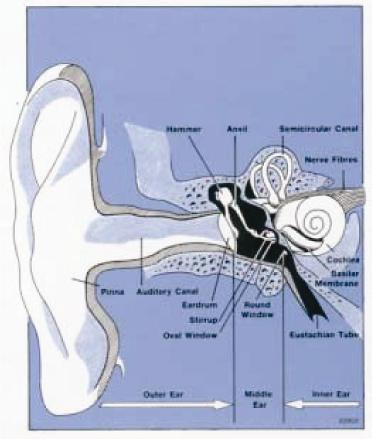|
The human ear consists of three main parts; the outer ear, middle ear and inner ear. The outer ear, consisting of the pinna and auditory canal, collects the airborne sound waves which then vibrate the eardrum, which is the interface with the middle ear. The middle ear acts as an impedance matching device and has three small bones operating as a set of levers. These bones transfer the vibration to the inner ear which consists of two separate systems, the semi-circular canals for controlling balance and the cochlea. The cochlea is a fluidfilled, snail-shaped tube which is divided longitudinally into two parts by the basilar membrane.
In response to an acoustic stimulus the fluid in the cochlea is disturbed and this distorts the basilar membrane on whose upper surface are thousands of very sensitive hair cells. The hair cells register this distortion and transform it into nerve impulses which are then transmitted to the brain.
Prolonged exposure to loud sounds causes damage to the hair cells with the result that hearing ability becomes progressively impaired. At first, damage to a few hair cells is not noticeable, but as more of the hair cells become damaged, the brain can no longer compensate for the loss of information. Words run into each other, speech and background noise cannot be distinguished and music becomes muffled. Considerable and irreparable damage will have occurred by the time the listener becomes aware of the loss. Loss of hearing caused by noise exposure is normally greatest at those frequencies (around 4 kHz) where the ear is most sensitive. (from Bruel & Kjar)
|



